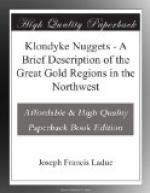“J. Dalton, a trader, has used a route overland from Chilkat Inlet to Fort Selkirk. Going up the Chilkat and Klaheela Rivers, he crosses the divide to the Tahkeena River and continues northward over a fairly open country practicable for horses. The distance from the sea to Fort Selkirk is 350 miles.
“Last summer a Juneau butcher sent 40 head of cattle to Cudahy. G. Bounds, the man in charge, crossed the divide over the Chilkat Pass, followed the shore of Lake Arkell and, keeping to the east of Dalton’s trail, reached the Yukon just below the Rink Rapids. Here the cattle were slaughtered and the meat floated down on a raft to Cudahy, where it retailed at $1 a pound.
“It is proposed to establish a winter road somewhere across the country travelled over by Dalton and Bounds. The Yukon cannot be followed, the ice being too much broken, so that any winter road will have to be overland. A thorough exploration is now being made of all the passes at the head of Lynn Canal and of the upper waters of the Yukon. In a few months it is expected that the best routes for reaching the district from Lynn Canal will be definitely known.
“It is said by those familiar with the locality that the storms which rage in the upper altitudes of the coast range during the greater part of the time, from October to March, are terrific. A man caught in one of them runs the risk of losing his life, unless he can reach shelter in a short time. During the summer there is nearly always a wind blowing from the sea up Chatham Strait and Lynn Canal, which lie in almost a straight line with each other, and at the head of Lynn Canal are Chilkat and Chilkoot Inlets. The distance from the coast down these channels to the open sea is about 380 miles. The mountains on each side of the water confine the currents of air, and deflect inclined currents in the direction of the axis of the channel, so that there is nearly always a strong wind blowing up the channel. Coming from the sea, this wind is heavily charged with moisture, which is precipitated when the air currents strike the mountains, and the fall of rain and snow is consequently very heavy.
“In Chilkat Inlet there is not much shelter from the south wind, which renders it unsafe for ships calling there. Capt. Hunter told me he would rather visit any other part of the coast than Chilkat.
“To carry the survey from the island across to Chilkoot Inlet I had to get up on the mountains north of Haines mission, and from there could see both inlets. Owing to the bad weather I could get no observation for azimuth, and had to produce the survey from Pyramid Island to Taiya Inlet by reading the angles of deflection between the courses. At Taiya Inlet I got my first observation, and deduced the azimuths of my courses up to that point. Taiya Inlet has evidently been the valley of a glacier; its sides are steep and smooth from glacial action; and this, with the wind almost constantly blowing




